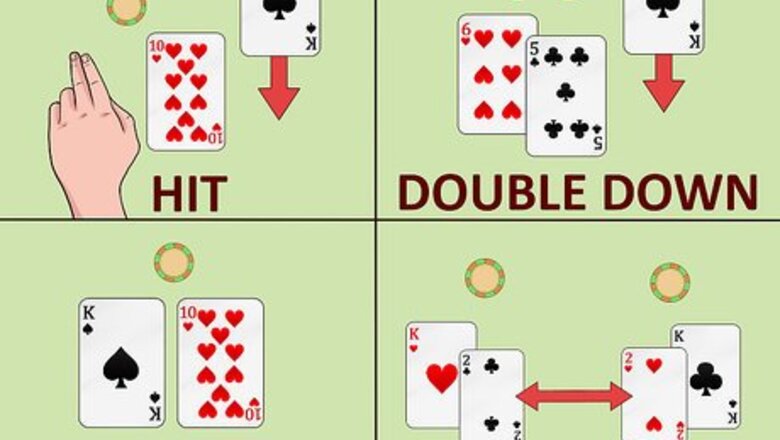
views
Learning from Scratch
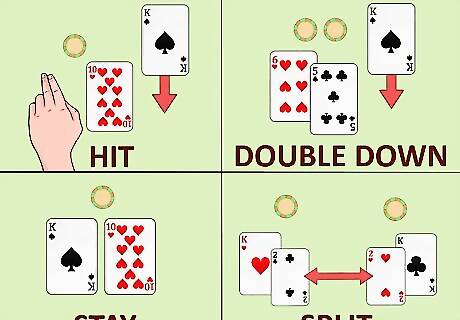
Memorize the basic terms of the game. The game itself is simple enough to figure out. Every player knows they need to get to 21 to beat the dealer. However, many players don’t understand the terms used beyond hitting to get another card or staying to end their term. Before you play, know about asking to double down, split your hand, or surrender your hand so you can incorporate these into your betting strategies and give yourself the best chance of winning. When you choose to double down, you double your bet and receive only one more card. When you have two of the same card, such as a pair of twos, you can split them and play them as two hands with two separate bets. Very few casinos allow you to surrender your hand. When you have a bad hand, you can surrender and save half your bet.
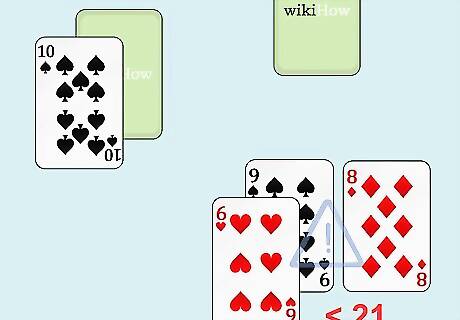
Mitigate the house advantage. The dealer gains an advantage because the player must act first without knowing what the hole card, the face-down card, is. Also, once you go over 21, or bust, you lose even if the dealer busts as well. Once you understand this, you’ll realize that winning depends upon reacting to the cards you have as well as those other players and the dealer show on the table in order to predict what card the dealer has face-down.
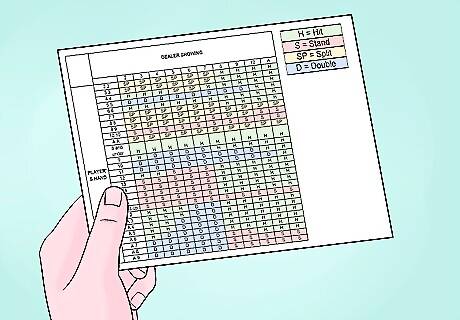
Study basic blackjack strategy. Because blackjack is a game of probabilities compared to other casino games, you will be a stronger player by learning how to play certain hands. For example, do you hit on your 16 when the dealer has a ten? Do you split your eights? Study a chart to determine which choice you should make depending on what cards you have and what card the dealer shows. At first you’ll find it hard to remember how to act during various in-game scenarios, but the more you play, the more you’ll learn how to play your hand by instinct.

Find out the table’s game rules before you start playing. Different casinos or blackjack games feature different rules. Many games use multiple decks of cards in order to discourage card counting, throwing off your ability to track your odds of winning. Most games of blackjack require the dealer to stop at 17, even if this means the dealer loses, but the rules may allow for the dealer to hit on a soft 17, which is a 17 made with an ace (the ace can be a one or an 11). A game that makes it harder for you to win in the long term, such as one that allows the dealer to hit on a soft 17, should be avoided. Avoid continuous shuffle machines when playing in person. These machines make keeping track of possible cards you and the dealer can draw an impossibility.

Check the table’s blackjack rules. Before you start playing at a table, it’s important to find out how you will be paid for a blackjack. If you get a natural blackjack, a 21 on the first two cards dealt to you, a table may pay you 3:2, which is $3 for every $2 wagered. Others will pay you less, such as 6:5, and should be avoided. 6:5 odds are worse for you than 3:2. Consider that if you bet and win twice on the first odds, you’ll bet ten units to win 12 units. 12 units on the second odds makes for four bets totalling eight units bet to win 12 units.
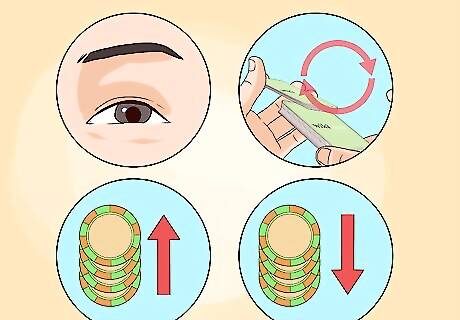
Formulate your betting strategy. In an average game, it’s best to be consistent or, at most, increase your bet by one dollar or other unit of measurement until you win. Remember that there is no such thing as being due for a win or hot and cold decks. Any such pattern you perceive will disappear over time because the game is based on chance and probability. Instead, try betting low after a loss or deck shuffle and increase your bet a little when you perceive the odds are in your favor.
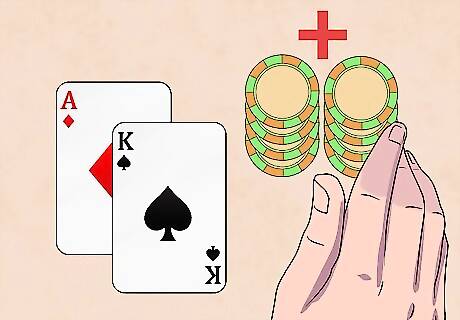
Increase your bet when the odds are in your favor. Many high cards in the deck work better for you since they always amount to ten and help you get more blackjacks. The more you play, the more you’ll gain a sense of how many helpful cards remain in the deck and how to proceed with the hand you have. Once you have a grasp of your odds of winning, you can more aggressively bet on good hands.
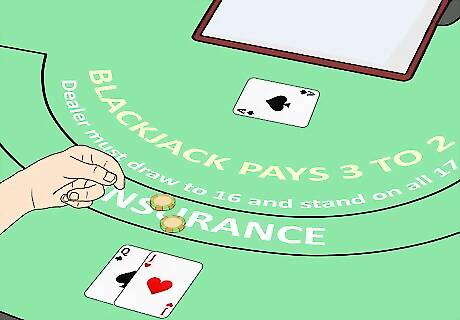
Resist buying insurance. The dealer will give you an option to buy protection in case the dealer has a blackjack. This means you in essence make a side bet that the dealer will have blackjack. If the dealer does have blackjack, you will win your side bet but lose your original bet. This may get you back some money in the short-term, but long-term the bet makes the casino money. Beginner players have no way of knowing if the dealer has a card worth ten points face-down under an ace. Card counters however have a better idea and can use their information to make money on this bet.
Counting Cards
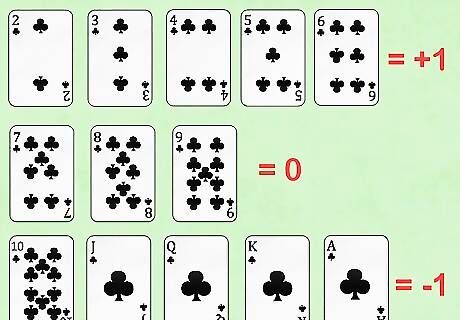
Assign values to cards. Under the Hi-Lo method of card counting, each numbered card has a value. Cards two through six are worth one point. Cards seven through nine are worth zero points. The ten card, face cards, and the aces are worth negative one point each. The idea is that you’ll keep a total value of all the cards on display, and as more face cards are left in the deck you’ll make more blackjacks while the dealer busts more. The Hi-Lo method is a common counting system, but other systems exist that give different point values to certain cards such as aces and fives.

Practice keeping a running count. Use a single deck of cards. Turn over the cards one by one, adding up the values as you go. If you draw a two, a five, and an ace, you’ll have a value of one. When you reach the end of the deck, your running total should equal zero. Repeat practice until you’re able to keep your total quickly and quietly.
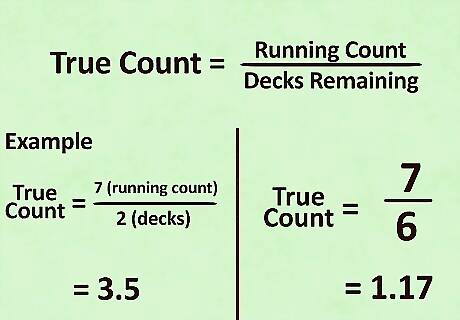
Keep a true count. Casinos are wise to card counters, so they play blackjack with multiple decks at the same time. The true count takes the running count and divides it by the number of decks in play. This count gives you more of an idea of how much of an advantage you have in betting. A running count of three is fine in a one-deck game, but this number means less when there are multiple decks since there are more cards to factor that reduce your chances of winning. For example, a seven running count divided by two decks leaves you with a true count of about three. But if there are six decks in play, the true count is only about one.
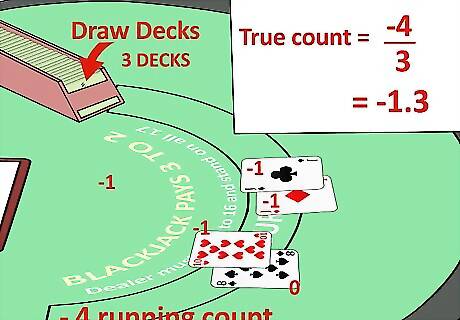
Practice maintaining true counts. Start off by using a few decks. Flip over the cards one by one and grow accustomed to dividing with fractions. At first you can simply round the division into a general true count, but as you go you’ll become more able to perform more accurate divisions in your head with less effort. An online card counting simulator can help you practice. Some simulators can correct your counting mistakes and track your winnings.
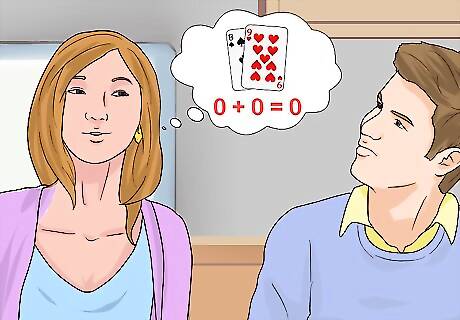
Keep a count with distractions. Once you feel comfortable keeping a true count, try mimicking the feel of a casino. First, start small. Add a little music or radio chatter. As you grow more capable, bring in a friend, roommate, or partner. Later on you can practice during loud events such as parties. Eventually you’ll be able to carry on conversations while calculating the true count in your mind.

Adjust your betting. When you put your calculations to practice, raise the amount you bet when the count is high in the positives. Remember to remain inconspicuous. Remain natural, talking to other players and the dealer rather than muttering to yourself. Raise your bet by small amounts when you can and lower your bets when you lose. Instead of sitting around at a table for hours, leave when your winning begins to attract suspicion. Card counting is legal but casinos frown upon it because it costs them money.

















Comments
0 comment